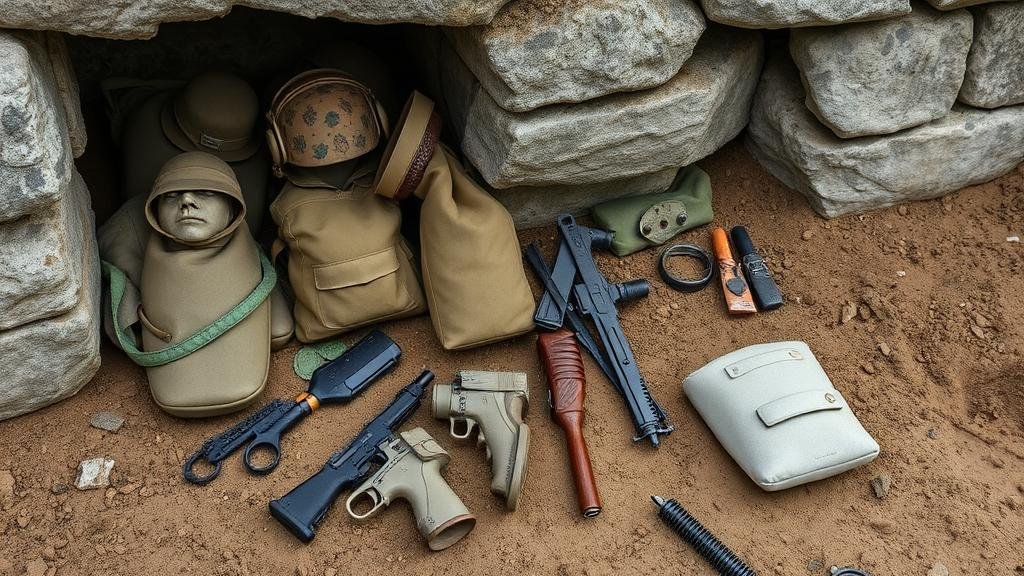Unearthing Personal Belongings of Soldiers in Battlefield Shelters
Unearthing Personal Belongings of Soldiers in Battlefield Shelters
The unearthing of personal belongings from soldiers in battlefield shelters offers profound insights into the human experience of war. These items serve not only as artifacts of military history but also as vessels of memory, emotion, and identity. This article aims to delve into the significance of these findings, the implications for historical narratives, and the methodologies used in their recovery and analysis.
The Importance of Personal Belongings
Soldiers often carry personal items that connect them to their lives before the battlefield. e belongings can range from letters and photographs to personal hygiene products and mementos. Understanding the significance of these items aids historians and archaeologists in reconstructing the lives of soldiers during conflicts. For example, a soldiers diary discovered in a trench offers insight not only into their thoughts and feelings but also into the socio-political conditions of that era.
- Emotional Significance: Items like letters home reflect the emotional states of soldiers, providing a tangible connection to their loved ones.
- Cultural Insights: Artifacts such as religious tokens or national insignia reveal the personal beliefs and affiliations of soldiers.
The process of recovering personal belongings from battlefield shelters often involves a combination of archaeological methods, historical research, and modern technology. Key methodologies include:
- Excavation Techniques: Systematic digging and stratigraphic analysis allow researchers to unearth layers of historical significance. Sites like the battlefields of World War I have been meticulously excavated to recover personal items that tell stories of the soldiers who fought there.
- Metal Detection: Metal detectors are routinely used to locate metallic belongings, such as dog tags, weapons, and personal effects. This approach has been instrumental in various World War II sites across Europe, where metal detectors have uncovered many soldiers artifacts.
Case Studies
Several notable case studies illustrate the importance of these findings:
- The Lost Battalion (World War I): The discovery of personal items belonging to American soldiers trapped behind enemy lines has led to a deeper understanding of their harrowing experiences. Items found include letters and photographs that paint a vivid picture of their final days.
- Normandy D-Day Sites (World War II): At Normandy, the recovery of personal items such as helmets, ration packs, and personal letters has provided insights into the soldiers preparations and combat experiences during the invasion.
Implications for Historical Narratives
The recovery of personal belongings significantly alters historical narratives, shifting the focus from collective military strategy to individual soldier experiences. This shift emphasizes the human aspect of war, offering a more nuanced understanding of the impacts of conflict. For example, personal artifacts recovered from the trenches of the Somme have provided perspectives on trench warfare that conventional military histories often overlook.
Challenges and Ethical Considerations
While the recovery of personal belongings is valuable, it poses several challenges and ethical considerations:
- Ownership and Respect: Questions arise regarding the ownership of these artifacts. Many items belonged to soldiers who may have surviving family members, leading to a moral obligation to return such belongings.
- Preservation vs. Display: Decisions must be made about how these items should be preserved. Exhibition can help inform and educate the public but may also risk damaging sensitive items.
Conclusion and Actionable Takeaways
Unearthing personal belongings from soldiers in battlefield shelters is a critical endeavor that enriches our understanding of history and the human experience of war. By embracing both the emotional and factual narratives that these items convey, we can foster a greater appreciation of the sacrifices made by individuals in the name of conflict. For historians, archaeologists, and the general public, the takeaways from these findings emphasize the importance of preservation, respect for the past, and a commitment to informing future generations about the realities of war.



